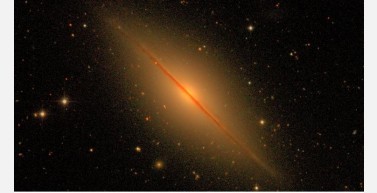|

Press Release 05-117
Scanning the Universe, Round Two

July 12, 2005
The Sloan Digital Sky Survey (SDSS) is entering a new phase with new goals.
SDSS is already the most ambitious astronomical survey project ever undertaken. During its five years of operation, the 300-plus scientists in the SDSS consortium have mapped galaxies, stars and quasars by the hundreds of millions over a large swath of sky. Their large-scale and very detailed surveys have confirmed that the galaxies follow a lacy, foam-like pattern that may well owe its existence to quantum effects during the Big Bang. They have identified far-off quasars that had already burst into life when the universe was just 900 million years old and barely out of infancy. They have found evidence that our own Milky Way galaxy grew by cannibalizing smaller companion galaxies.
Now, with new partners and a new round of funding, the SDSS team is ramping up in a new way.
The three-year SDSS-II project, announced on July 11, 2005, will include three components:
- The LEGACY initiative, which will complete the SDSS survey of the extragalactic universe, obtaining images and distances of nearly a million galaxies and quasars over a continuous swath of sky in the Northern Hemisphere.
- The Sloan Extension for Galactic Understanding and Exploration (SEGUE), a new effort aimed at mapping the structure and stellar makeup of the Milky Way Galaxy, and gathering data on how the Milky Way formed and evolved.
- An intensive study of supernovae, which are gigantic explosions produced by dying stars. By sweeping the sky to find these explosions, and then precisely measuring how far away they are, the SDSS-II astronomers will be able to measure the rate of expansion of the universe with remarkable accuracy.
The SDSS-II project is supported by the Alfred P. Sloan Foundation in New York City; the National Science Foundation (NSF); the U.S. Department of Energy; the Japanese Monbukagakusho; and the Max Planck Society in Germany.
For more information, see the SDSS news release.
-NSF-
SDSS-II is managed by the Astrophysical Research Consortium for the Participating Institutions:
- The American Museum of Natural History
- The University of Basel
- Cambridge University
- Case Western Reserve University
- The University of Chicago
- Fermilab
- The Institute for Advanced Study
- The Japan Participation Group
- The Johns Hopkins University
- The Joint Institute for Nuclear Astrophysics
- The Kavli Institute for Particle Astrophysics and Cosmology
- The Korean Scientist Group
- Los Alamos National Laboratory
- The Ohio State University
- The Max-Planck-Institute for Astronomy
- The Max-Planck-Institute for Astrophysics
- New Mexico State University
- University of Pittsburgh
- University of Portsmouth
- Astrophysical Institute Potsdam
- Princeton University
- The United States Naval Observatory
- The University of Washington.

Media Contacts
Gary S. Ruderman, Sloan Digital Sky Survey II (312) 320-4794 sdsspio@aol.com
M. Mitchell Waldrop, NSF (703) 292-7752 mwaldrop@nsf.gov
Co-Investigators
Michael Strauss, Scientific Spokesperson (609) 258-3808 strauss@astro.princeton.edu
Related Websites
Sloan Digital Sky Survey site: http://www.sdss.org/
SDSS-II News Release: http://www.sdss.org/news/releases/20050711.sdssII.html

The National Science Foundation (NSF) is an independent federal agency that supports fundamental research and education across all fields of science and engineering. In fiscal year (FY) 2009, its budget is $9.5 billion, which includes $3.0 billion provided through the American Recovery and Reinvestment Act. NSF funds reach all 50 states through grants to over 1,900 universities and institutions. Each year, NSF receives about 44,400 competitive requests for funding, and makes over 11,500 new funding awards. NSF also awards over $400 million in professional and service contracts yearly.
 Get News Updates by Email Get News Updates by Email
Useful NSF Web Sites:
NSF Home Page: http://www.nsf.gov
NSF News: http://www.nsf.gov/news/
For the News Media: http://www.nsf.gov/news/newsroom.jsp
Science and Engineering Statistics: http://www.nsf.gov/statistics/
Awards Searches: http://www.nsf.gov/awardsearch/
| 


